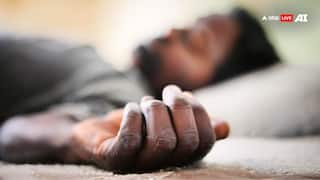World Sight Day 2021: Why 80% Of Visually Impaired People Are Avoidably So & What Can Be Done To Prevent This
Sightsavers India, which is part of a global organisation working to eliminate avoidable blindness, says people with visual impairment are cut off when it comes to education, healthcare and jobs

New Delhi: Globally, at least 1 billion people have a near or distance vision impairment that is preventable or is yet to be addressed, according to the World Health Organization (WHO).
Vision impairment and blindness affect daily activities, and also work opportunities.
Most of the people affected with vision impairment are above 50 years of age, and the leading causes of vision impairment are unoperated cataract and uncorrected refractive error. Age-related macular degeneration, glaucoma, diabetic retinopathy, infectious eye diseases and trauma also cause vision impairment.
At the 74th World Health Assembly held from May 24 to June 1, the member states adopted two new global targets for eye care by 2030 — a 40 per cent increase in effective courage of refractive errors and a 30 per cent increase in effective courage of cataract surgery.
These aim to increase global eye care coverage in the future and help in providing quality services.
World Sight Day (WSD) is observed internationally, on the second Thursday of October, to focus attention on the global issue of eye health. This year, World Sight Day is on October 14.
The global event draws attention towards blindness, visual impairments, and the prevention methods of both.
Sightsavers India, which is part of a global development organisation that has been working in India since 1966 to eliminate avoidable blindness, told ABP Live about the severity of vision impairment in the country, what can be done to prevent avoidable vision impairment, and other aspects of eye health care.
‘India is home to a third of the world’s blind population’
Vision impairment is a major problem in India. Sightsavers India says it is working to ensure people who are irreversibly blind are supported adequately to lead lives of independence and dignity.
"India is home to a third of the world’s blind population. The country has around 12 million individuals with visual impairment as against the global total of 39 million, according to a report published by the National Programme for Control of Blindness (NPCB). However, when it comes to accessible education, healthcare and employment, people with visual impairment are cut off,” RN Mohanty, the CEO of Sightsavers India, told ABP Live.
He adds: “Only 29.16 per cent of the blind in India are part of the education system as per a survey conducted by the National Council of Educational Research and Training (NCERT). The prevalence of blindness is higher among populations who come from lower socio-economic strata. It is found that the prevalence of blindness in women is higher as compared to males especially in rural areas."
According to the WHO, 3 out of 4 visually impaired people in the world are avoidably so.
Talking about this in reference to India, Mohanty said: "India has the largest population of blind people in the world. Most of them live in the poorest parts of the country with little or no access to even basic health care facilities. Many people could have been prevented from going blind if they had received timely treatment. But poverty – which is both a cause and effect of blindness – can be very hard to break out of, especially in the rural areas where most blind people live."
Speaking about what can be done to prevent avoidable vision impairment, he said a regular comprehensive eye check-up is very important in the early identification of potentially blinding conditions like glaucoma and diabetic retinopathy. "It is advisable to have a timely consultation for common issues such as blurring of distance vision or progressive difficulty in reading. In any case, if there are any eye-related problems, self-medication is never advisable and one must visit a formal facility for a complete check-up."
He also talked about the initiatives taken by Sightsavers India to prevent and cure vision impairment. The organisation claims to have touched the lives of 55 million people across 100 districts in eight states over the last five decades.
"Sightsavers in India runs many eye health programmes. The Rural Eye Health Programme, also known as Netravasant, targets populations residing in rural areas. It focusses on setting up eye care centres for screening and treating cataract,” Mohanty said.
As part of the School Eye Health Programme, called Vidyajyothi, the organisation provides “facilities like free eye check-ups, provision of spectacles to correct refractive errors, and even conduct awareness sessions about the importance of eye health”.
There are also the Urban Eye Health Programme, or Amrita Dristhi, that caters to the urban slum population, and Raahi, the National Truckers Eye Health Programme, which aims to help truck drivers keep a better eye on the roads.
‘Children must take frequent breaks in between online sessions’
Mohanty also talked about how screen time is contributing to the worsening eye health of people, including children. "Since the pandemic started, there has been an alarming increase in the engagement of children and adults with various forms of digital technology. Whether it is for work from home, attending a meeting, academic session or social occasions, digital interactions have become the norm. There are also indications that prolonged screen exposure coupled with reduced outdoor activities is leading to progression in the glass numbers (myopia) in children."
Due to the newly imposed challenges of the pandemic, he said, there is a need to create a new set of eye health practices for children and adults alike.
Mohanty told ABP Live that parents or guardians of children need to develop a daily routine for them that includes all elements of academics, creativity, physical exercise and social interactions, to ensure good eye health for children who are spending excessive time online. "There should be regulated hours limited to only essential school related work and other planned pleasure activities. The children ought to have frequent breaks in between the online sessions. One should make sure that his/her child is well hydrated. Nutritious food like green vegetables and fresh fruits also help keep the eyes healthy," he said.
Check out below Health Tools-
Calculate Your Body Mass Index ( BMI )
Calculate The Age Through Age Calculator






































